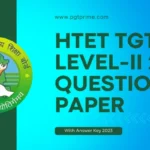We are excited to provide the detailed KVS LDCE History Question Paper and Answers PDF 2023. This material is crucial for various competitive exams and should be practiced diligently. The KVS LDCE History question paper and answers PDF 2023 is equally useful for students preparing for UGC, NET, UPSC, Central, and State level teaching exams.
The History Paper is divided into four parts: Ancient History, Medieval History, Modern History, and World History. There are a total of 120 questions, with questions from each section.
By examining the departmental exam, one can gain a better understanding of the subject matter and the level of difficulty they can expect to encounter on the KVS PGT History exam.
Important
If you want to download the entire KVS LDCE question paper and answers PDF, refer to our article “The Hidden Gems: KVS LDCE Question Paper 2023 download”. In this article, we’ve covered essential details about the LDCE, and all bilingual KVS LDCE 2023 question papers for all subjects are made available as a complete package.
KVS LDCE History Question Paper and Answers PDF 2023
We are hesitant to provide detailed solutions; however, your comments keep us motivated. We request you to keep us motivated through your comments and request you to subscribe to our Facebook, X (formerly Twitter), or Telegram channel for all our latest updates.
Now, all the students related to the history subject, look at these questions and their given answers with us, understand them, and improve your preparation. Let’s get started.
KVS LDCE History Question Paper and Answers PDF 2023
1. Which of the following languages became popular in Mesopotamia after 1400 BCE and is still spoken in some areas?
- Sumerian
- Akkadian
- Hebrew
- Aramaic
Answer: KVS LDCE History Question Paper and Answers PDF 2023
(4) Aramaic
Aramaic is an ancient Semitic language that was widely used in the Near East, including Mesopotamia, from around the 10th century BCE until the 7th century CE. It was spoken by various civilizations, including the Assyrians, Babylonians, Persians, and Jews.
2. Arrange the following in chronological order :
- Rudradaman
- Vatsyayana
- Gautamiputra Satakarni
- Yajashri Satakarni
Select the correct Answer from the code given below: KVS LDCE History Question Paper and Answers PDF 2023
- (i), (iii), (iv), (ii)
- (iii), (i), (iv), (ii)
- (iv), (ii), (i), (iii)
- (ii), (i), (iii), (iv)
Answer: KVS LDCE History Question Paper and Answers PDF 2023
(2) (iii), (i), (iv), (ii)
The correct chronological order for the given names is as follows:
- Gautamiputra Satakarni: was the greatest king of Satavahana dynasty in 106 CE.
- Rudradaman: Rudradaman and Gautamiputra Satakarni were contemporaries and rulers of different regions in ancient India.
- Yajashri Satakarni :Great grand son of Gautamiputra Satakarni.
- Vatsyayana : Gautamiputra Satakarni, Rudradaman, and Yajashri Satakarni all belong to the post-Mauryan era in Indian history whereas Vatsyayana belongs to Gupta period.
3. Arrange the following in chronological order.
- Satapath Brahman
- Panchavimsha Brahmana
- Dighanikaya
- Apastambha Dharmasutra
Select the correct Answer from the code given below : KVS LDCE History Question Paper and Answers PDF 2023
- (ii), (i), (iv), (iii)
- (iii), (iv), (i), (ii)
- (iv), (ii), (iii), (i)
- (i), (iii), (ii), (iv)
Answer: KVS LDCE History Question Paper and Answers PDF 2023
(1) (ii), (i), (iv), (iii)
The correct chronological order for the given names is as follows:
- (Panchavimsha Brahmana) Samaveda.
- (Satapath Brahmana) Yajurveda.
- Apastambha Dharmasutra (associated with the Vedic tradition).
- Dighanikaya (part of the Buddhist literature, Sutta Pitaka).
4. Arrange the following in chronological order:
- Harappa
- Sanauli
- Kunal
- Hastinapur
Select the correct Answer from the code given below : KVS LDCE History Question Paper and Answers PDF 2023
- (i), (iii), (iv), (ii)
- (iii), (i), (ii), (iv)
- (iv), (ii), (iii), (i)
- (ii), (iv), (i), (iii)
Answer: KVS LDCE History Question Paper and Answers PDF 2023
(2) (iii), (i), (ii), (iv)
The correct chronological order is as follows:
- Kunal (Stone Age).
- Harappa (Indus Valley Civilization).
- Sanauli (Chalcolithic culture).
- Hastinapur (Vedic culture and Mahajanapada era).
5. Arrange the following archaeological sites in chronological order :
- Piprahwa
- Prakash
- Dholavira
- Mangalkot
Select the correct Answer from the code given below: KVS LDCE History Question Paper and Answers PDF 2023
- (iii), (ii), (iv), (i)
- (ii), (iv), (i), (iii)
- (iv), (i), (iii), (ii)
- (i), (iii), (ii), (iv)
Answer: KVS LDCE History Question Paper and Answers PDF 2023
(1) (iii), (ii), (iv), (i)
The correct chronological order for the given archaeological sites is as follows:
- Dholavira (Indus Valley Civilization).
- Prakash (Chalcolithic culture).
- Mangalkot (Ancient fortified site).
- Piprahwa (Buddhist site).
6. Arrange the following administrative units in order of their descending power structure :
- Veethi
- Gram
- Vishaya
- Bhukti
Select the correct Answer from the code given below: KVS LDCE History Question Paper and Answers PDF 2023
- (iii), (iv), (i), (ii)
- (iv), (iii), (i), (ii)
- (ii), (i), (iii), (iv)
- (i), (ii), (iv), (iii)
Answer: KVS LDCE History Question Paper and Answers PDF 2023
(2) (iv), (iii), (i), (ii)
The correct order of the administrative units in descending power structure is as follows:
- Bhukti
- Vishaya
- Veethi
- Gram
Bhukti represents a larger administrative division, often equivalent to a state. Vishaya is a smaller administrative unit, often equivalent to a district or region. Veethi represents a smaller locality, and Gram refers to a village. All these terms belong to Gupta administration.
7. Match List – I with List – II and select the correct Answer from the code given below :
| List – I | List – II |
| (a) Kadambari | (i) Aryabhatt |
| (b)Mrichchhakatikam | (ii) Banabhatta |
| (c) Aryabhattiya | (iii) Varahamihir |
| (d) Brihatasamhita | (iV) Shudraka |
Code : KVS LDCE History Question Paper and Answers PDF 2023
- (ii),(iv),(i),(iii)
- (iv),(i),(iii),(ii)
- (i),(iii),(ii),(iv)
- (iii),(ii),(iv),(I)
Answer: KVS LDCE History Question Paper and Answers PDF 2023
(1) (ii),(iv),(i),(iii)
The correct match between List I and List II is as follows:
| (a) Kadambari | (ii) Banabhatta |
| (b) Mrichchhakatikam | (iv) Shudraka |
| (c) Aryabhattiya | (i) Aryabhatta |
| (d) Brihatasamhita | (iii) Varahamihir |
Kadambari, written by Banabhatta, is a significant work of classical Sanskrit literature. Banabhatta, a renowned poet and scholar, composed this enchanting romantic tale during the 7th century CE.
Mrichchhakatikam, also known as “The Little Clay Cart,” is a renowned Sanskrit play written by Shudraka, a playwright believed to have lived during the 5th century CE.
Aryabhattiya is a renowned mathematical and astronomical treatise written by Aryabhatta, an ancient Indian mathematician and astronomer who lived during the 5th century CE.
Brihatasamhita, written in Sanskrit, and authored by Varahamihira, is an ancient Indian text that encompasses a wide range of subjects, including astrology, astronomy, mathematics, geography, architecture, and more.
8. Match List – I with List – II and select the correct Answer from the code given below :
| List-I | List-II |
| (a) Dashagitikasutra | (i) Aryabhatt |
| (b) Panchasidhantika | (ii) Varahamihir |
| (c) Yogachara | (iii) Asanga |
| (d) Jainendra Vyakarana | (iv) Devanandi |
Code:
| a | b | c | d | |
| (1) | (iv) | (iii) | (ii) | (i) |
| (2) | (iii) | (ii) | (i) | (iv) |
| (3) | (ii) | (i) | (iv) | (iii) |
| (4) | (i) | (ii) | (iii) | (iv) |
Answer: KVS LDCE History Question Paper and Answers PDF 2023
(4) (i),(ii),(iii),(iv)
The correct match between List I and List II is as follows:
| (a) Dashagitikasutra | (i) Aryabhatta |
| (b) Panchasidhantika | (ii) Varahamihir |
| (c) Yogachara | (iii) Asanga |
| (d) Jainendra Vyakarana | (iv) Devanandi |
Aryabhatta’s Dashagitikasutra is known for its concise and systematic approach to mathematics. It introduces the concept of place value system and decimal notation.
Panchasidhantika is a remarkable astronomical treatise composed by the renowned Indian astronomer Varahamihir. In this work, Varahamihir presents a compilation and synthesis of five different astronomical schools of thought prevalent during his time. These schools include the Surya Siddhanta, Romaka Siddhanta, Paulisa Siddhanta, Vasishtha Siddhanta, and Paitamaha Siddhanta.
Yogachara, One of the key proponents of Yogachara is the renowned Indian Buddhist philosopher Asanga. His most notable work is the Mahayanasamgraha, a comprehensive text that provides a systematic overview of the Yogachara philosophy.
Jainendra Vyakarana is a significant work in the field of grammar associated with the Jain tradition.
9. Match List-I with List-II and select the correct Answer from the code given below :
| List-I | List-II |
| (a) Chedi | (i) Mathura |
| (b) North Panchal | (ii) Vairat |
| (c) Matsya | (iii) Shaktimati |
| (d) Sursena | (iv) Ahichchhatra |
Code:
| (a) | (b) | (c) | (d) | |
| (1) | (ii) | (i) | (iv) | (iii) |
| (2) | (iii) | (iv) | (ii) | (i) |
| (3) | (iv) | (ii) | (i) | (iii) |
| (4) | (i) | (iii) | (iv) | (ii) |
Answer: KVS LDCE History Question Paper and Answers PDF 2023
(2) (iii),(iv),(ii),(i)
Here is the corrected match between List-I and List-II for the Mahajanapadas and their capitals:
| List-I | List-II |
| (a) Chedi | (iii) Shaktimati |
| (b) North Panchal | (iv) Ahichchhatra |
| (c) Matsya | (ii) Vairat |
| (d) Sursena | (i) Mathura |
There were 16 Mahajanapadas and these Mahajanapadas were ancient kingdoms or republics in the Indian subcontinent during the 6th to 4th centuries BCE.
10. Match List – I with List – II and select the correct Answer from the code given below :
| List-I | List-II |
| (a) Ladakhan Temple | (i) Nalanda |
| (b) Prabhawatigupta | (ii) Pulkeshin-II |
| (c) Aihole Inscription | (iii) Rudrasen-II |
| (d) Dharmayagya | (iv) Bijapur |
Code: KVS LDCE History Question Paper and Answers PDF 2023
| a | b | c | d | |
| (1) | (iv) | (iii) | (ii) | (i) |
| (2) | (iii) | (ii) | (i) | (iv) |
| (3) | (ii) | (i) | (iv) | (iii) |
| (4) | (i) | (ii) | (iii) | (iv) |
Answer: KVS LDCE History Question Paper and Answers PDF 2023
(1) (iv),(iii),(ii),(i)
The correct match between List-I and List-II is as follows:
| List-I | List-II |
| (a) Ladakhan Temple | (iv) Bijapur |
| (b) Prabhawatigupta | (iii) Rudrasen-II |
| (c) Aihole Inscription | (ii) Pulkeshin-II |
| (d) Dharmayagya | (i) Nalanda |
The Chalukya Shiva Temple (earlier known as Lad Khan Temple), dedicated to Shiva, is one of the oldest Hindu temples and is located in the group of monuments at Aihole in the state of Karnataka.
Prabhawatigupta, also known as Prabhavati, was the daughter of Chandragupta II, the great Gupta emperor. She was married to Rudrasen-II, who was a powerful ruler of the Vakataka dynasty. Prabhawatigupta’s marriage alliance with Rudrasen-II helped forge a strong political relationship between the Guptas and the Vakatakas.
The Aihole Inscription holds great historical significance and provides valuable insights into the reign of Pulkeshin-II, a renowned ruler of the Chalukya dynasty. It is one of the earliest known inscriptions in the Kannada language and sheds light on the socio-political and cultural aspects of the time.
Dharmayagya holds a significant institution in the history of Nalanda, one of the most renowned ancient centers of learning in India. It represents the profound spiritual and intellectual pursuits that were integral to the culture and education system of Nalanda.
11. Match List-I with List-II and select the correct Answer from the code given below :
| List-I | List-II |
| (a) Besnagar Garud pillar inscription | (i) Pulumavi |
| (b) Mandsor stone inscription | (ii) Guild of weavers |
| (c) Madhuban copperplate | (iii) Harsha |
| (d) Nasik cave inscription | (iv) Haliodorous |
Code: KVS LDCE History Question Paper and Answers PDF 2023
| (a) | (b) | (c) | (d) | |
| (1) | (iv) | (ii) | (iii) | (i) |
| (2) | (ii) | (iii) | (i) | (iv) |
| (3) | (iii) | (i) | (iv) | (ii) |
| (4) | (i) | (iv) | (ii) | (iii) |
Answer: KVS LDCE History Question Paper and Answers PDF 2023
(1) (iv),(ii),(iii),(i)
The correct matching between List-I and List-II is as follows:
| List-I | List-II |
| (a) Besnagar Garud pillar inscription | (iv) Heliodorus |
| (b) Mandsor stone inscription | (ii) Guild of weaver |
| (c) Madhuban copperplate | (iii) Harsha |
| (d) Nasik cave inscription | (i) Pulumavi |
The Besnagar Garud pillar inscription is an important historical artifact dating back to the 2nd century BCE. It is attributed to Heliodorus, a Greek ambassador and devotee of Vasudeva (Krishna). The inscription, written in Brahmi script, provides valuable insights into the cultural and religious exchanges between the Greeks and Indians during that period.
The Mandsor stone inscription is an ancient inscription found in Mandsaur (Mandsor), Madhya Pradesh, India. The Mandsor stone inscription highlights the importance and influence of the guild of weavers in the economic and social fabric of the region.
The Madhuban copperplate inscription is an important historical document dating back to the reign of Emperor Harsha, who ruled over a large part of North India in the 7th century CE. The inscription was discovered in Madhuban, Uttar Pradesh, and is written on a copperplate.
The Nasik cave inscription, also known as the Nashik Prashasti, is an important inscription found in the caves of Nashik (Nasik), Maharashtra, India. It is attributed to King Pulumavi of the Satavahana dynasty, who ruled in the 1st century CE. The inscription is written in the Brahmi script and is considered one of the earliest known Sanskrit inscriptions in India.
12. Pataligrama, which later became the famous Mauryan metropolis Pataliputra, was founded by:
- Bimbisara
- Ajatasatru
- Sisunaga
- Chandragupta
Answer: KVS LDCE History Question Paper and Answers PDF 2023
(2) Ajatasatru
Ajatasatru, the son of King Bimbisara, established Pataligrama as the capital of Magadha around the 5th century BCE. The city flourished under subsequent Mauryan rulers, including Chandragupta Maurya and Ashoka the Great, and became a prominent political and economic center in ancient India.
13. Given below are two statements, one labeled as Assertion(A) and the other labeled as Reason(R):
- Assertion(A): Sanskrit became an official language in Bengal during fifth to seventh centuries.
- Reason(R): Government officials knew this language.
- Both(A) and (R) are true, but (R) is not the correct explanation of (A)
- (A) is true, but (R) is false
- (A) is false, but (R) is true
- Both (A) and (R) are true and (R) is the correct explanation of (A)
Answer: KVS LDCE History Question Paper and Answers PDF 2023
(1) Both(A) and (R) are true, but (R) is not the correct explanation of (A)
The statement (A) is a true statement as Sanskrit did indeed gain prominence and official recognition in Bengal during this period.
The fact that government officials knew Sanskrit does not serve as a sufficient explanation for Sanskrit becoming an official language in Bengal during that time period.
14. Given below are two statements, one label leads Assertion (A), and the other label leads Reason (R):
- Assertion (A): The state of Kamarupawas established in the seventh century.
- Reason(R): In early sixth century Sanskrit had come into prevalance.
Code: KVS LDCE History Question Paper and Answers PDF 2023
- Both (A) and (R) are true, but (R) is not the correct explanation of A
- (A) is true, but (R) is false
- (A) is false, but (R) is true
- Both (A) and (R) are true and (R) is the correct explanation of (A)
Answer: KVS LDCE History Question Paper and Answers PDF 2023
(2) (A) is true, but (R) is false.
The rise of Sanskrit as a prevalent language may have had some influence, but it does not provide a causal or explanatory link to the establishment of the state of Kamarupa.
15. Given below are two statements, one labeled as Assertion (A) and the other labeled as Reason (R) :
- Assertion (A): The Vakataka rulers served as a bridge in the growth of Brahmanism in southern India.
- Reason (R): The Vakataka rulers issued a number of land grants to the Brahmanas.
In the context of the above two statements which one of the following is correct?
Code: KVS LDCE History Question Paper and Answers PDF 2023
- Both (A) and (R) are true, but (R) is not the correct explanation of (A)
- (A) is true, but (R) is false
- (A) is false, but (R) is true
- Both (A) and (R) are true and (R) is the correct explanation of (A)
Answer: KVS LDCE History Question Paper and Answers PDF 2023
(4) Both (A) and (R) are true and (R) is the correct explanation of (A)
Vakataka dynasty, which ruled parts of central and southern India from the 3rd to the 5th century CE, had patronized Brahmanical institutions and supported Brahmanical rituals and practices.
Vakataka rulers were known for granting land and other privileges to Brahmanas, which further strengthened the influence of Brahmanism in the region.
16. Given below are two statements, one labeled as Assertion (A) and the other labeled as Reason (R):
- Assertion (A): The Rashtrakutas displaced the Chalukyas and established their kingdom in the Western Deccan.
- Reason(R): Feudal system played a decisive role in this context.
Code: KVS LDCE History Question Paper and Answers PDF 2023
- Both (A) and (R) are true, but (R) is not the correct explanation of (A)
- (A) is true, but (R) is false
- (A) is false, but (R) is true
- Both (A) and (R) are true and (R) is the correct explanation of (A)
Answer: KVS LDCE History Question Paper and Answers PDF 2023
(2) (A) is true, but (R) is false
The overthrow of the Chalukyas by the Rashtrakutas was not primarily driven by the feudal system. Instead, it was a result of complex political, military, and regional dynamics that involved power struggles, alliances, and territorial ambitions among various ruling dynasties of the time.
17. Who among the following is the author of Brahmsutra?
- Badarayan
- Shankar
- Ramanujam
- Kamban
Answer: KVS LDCE History Question Paper and Answers PDF 2023
(1) Badarayan
The Brahmasutra, also known as the Vedanta Sutra, is a foundational text of the Vedanta school of philosophy. It consists of aphoristic statements (sutras) that summarize the teachings of the Upanishads and provide a systematic analysis of the nature of reality, the self, and the relationship between the individual and the ultimate reality (Brahman).
18. Which among the following, is not an integral part of Charvaka philosophy?
- Materialistic approach
- Disbelief in moksh
- Belief in the other world
- Disbelief in yajnas
Answer: KVS LDCE History Question Paper and Answers PDF 2023
(3) Belief in the other world
Charvaka, also known as Lokayata, is a school of Indian philosophy known for its materialistic and atheistic approach. It rejects the existence of the supernatural, including the belief in an afterlife or otherworldly realms.
19. The word ‘Hindustan’occurred for the first time during third century in the inscriptions of :
- Greek rulers
- Sasanian rulers
- Turkish rulers
- Arab rulers
Answer: KVS LDCE History Question Paper and Answers PDF 2023
(2) Sasanian rulers
The word ‘Hindustan’ is believed to have first appeared during the third century in the inscriptions of the Sasanian rulers. The Sasanians were a Persian dynasty that ruled over a vast empire, including parts of present-day Iran and Central Asia.
20. Which of the following languages was the lingua franca of India in the third century BCE?
- Sanskrit
- Pali
- Prakrit
- Vedic Sanskrit
Answer: KVS LDCE History Question Paper and Answers PDF 2023
(3) Prakrit
Prakrit was a popular language derived from Sanskrit and was widely spoken and used for communication, administration, and literature during that time. Pali, another language derived from Prakrit, also gained prominence later, particularly in Buddhist scriptures.











